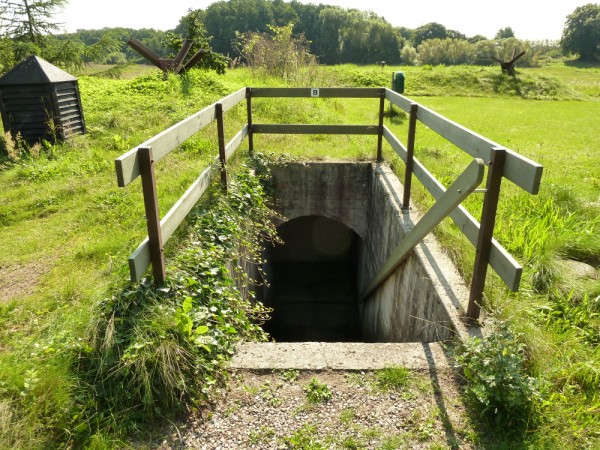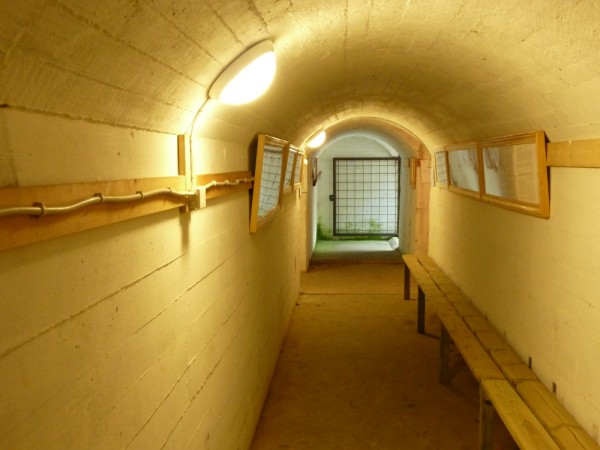The tenant
and the
landlord
Faaborg – Svendborg
The Black Death, the Little Ice Age, wars and leprosy. On the stretch between Svendborg and Faaborg the focus is on a period that featured a whole lot of hardship. The population was almost halved. There were long periods of crop failure and famine. But the period was also moving towards the state we know – for example, with a centrally controlled legal system and a monopoly of power. Royal power was strengthened, while the agricultural crisis and the lack of labour made the peasantry more uniform and self-confident. The church was the biggest loser.
So, welcome to a sombre story in a fertile landscape that keeps on giving. This is also the domain of Culinary South Funen. Discover the countless, small, local producers and enjoy the result of their tireless efforts.
The yellow bell tower, which can be seen from far away, is Faaborg’s most prominent landmark. People say, half jokingly and half seriously, that a true citizen of Faaborg never moves further away from the town than they are able to see the tower.
MANSIONS ON THIS ROUTE





Practical links to points of departure and destinations
Discover Svendborg (click here)
Attractions in Svendborg (click here)
Where to eat and drink in Svendborg (click here)
Where to stay in Svendborg (click here)
Discover Faaborg (click here)
Attractions in Faaborg (click here)
Where to stay in Faaborg (click here)
Arts and crafts en route
Food and drink en route
Stella Maris
Sometimes on a holiday you may fancy a gourmet treat in a league of its own, in which food, wine and good company all come together to form a perfect experience. If you are thinking along those lines, then Stella Maris is the place. This is a top-notch experience – and on the shoreline of South Funen into the bargain. You can also spend the night here. Find out more.
Gundestrup Dairy
Visit an authentic country dairy specialising in butter, cheeses – especially smoked cheese. In Denmark, we have been enjoying this mild, smoked fresh cheese since the Viking Age. This is the only cheese we Danes can really call our own. The dairy man is also a microbrewer and produces a number of lovely beers. NB: Limited opening hours. Find out more.
The Café at Gorilla Park
Enjoy a sandwich, a good cup of coffee, a soft drink and the magnificent view of South Funen from the café at Gorilla Park. Find it here.
Bicycle and luggage service during your trip
Route download to gpx
THE ROUTE
0
KM
Faaborg
The quintessentially idyllic southern Funen market town
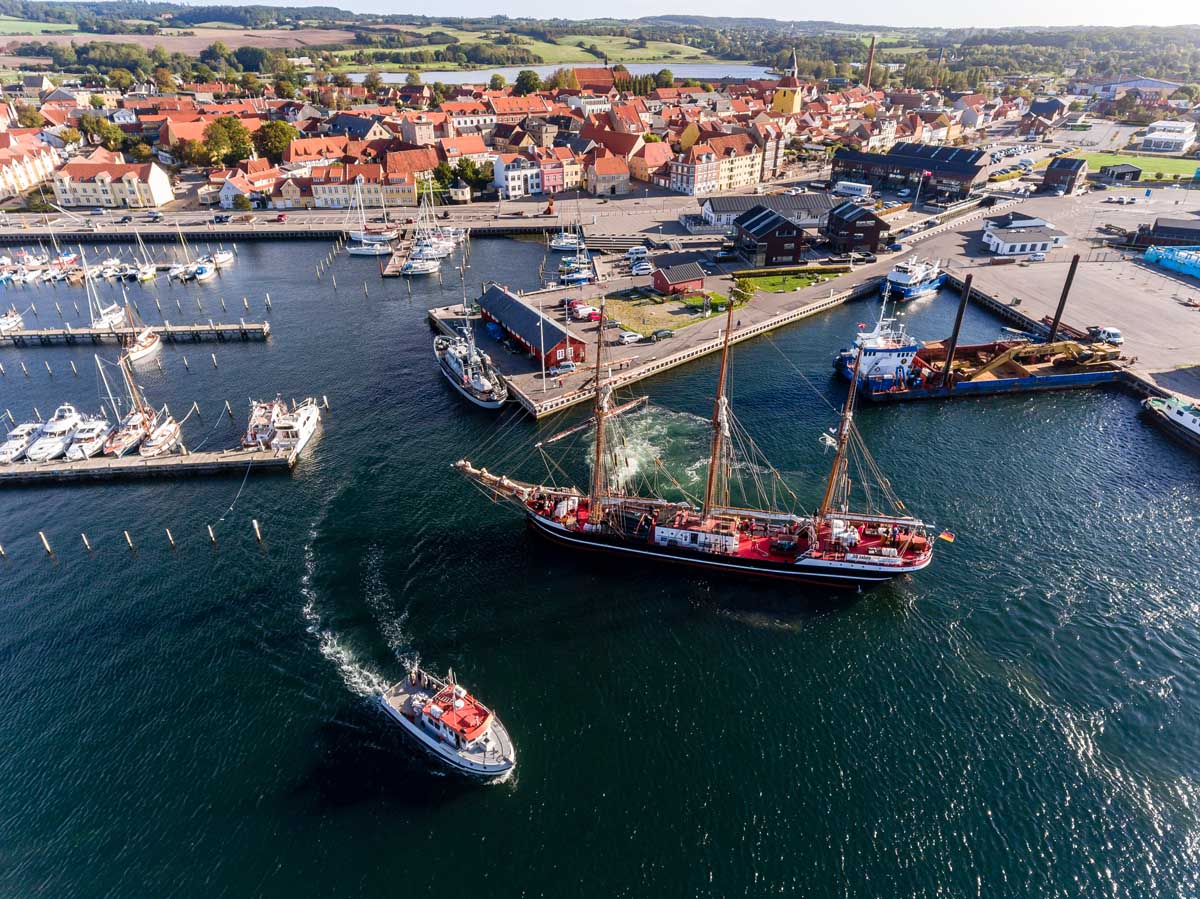
Before the 13th century, and for many years to come, most goods were transported by ship. The roads were too poor. Hence the creation of towns with access to the sea – or at least water, as in the case of Odense. This is why many market towns on Funen have proud maritime traditions. This certainly applies to Faaborg, which was granted royal borough status in the 13th century and quickly became a rich town.
The supreme landmark of the town is its yellow bell tower. The tower belonged to the town’s first stone church, which was dedicated to St. Nicholas. The present parish church, the Holy Spirit Church, was built by a Catholic mendicant order. Today, it is a beautiful, large church with monks’ chairs from the Roman Catholic period. Shortly after the Reformation, the king gave Holy Spirit Church to the municipality in exchange for the Church of St. Nicholas. The king’s plan was to use the inside of the church as a granary for the large grain export out of Faaborg. But the granary never came to anything. So the ship’s nave was demolished in the late 16th century, while the tower was allowed to remain standing. It is from here that the verger of the parish church still rings the bell to herald the start of services and church events.
Enjoy the old market town. It is the warmest town on Funen. Fortunately, you can find many cunning places where you can enjoy an ice cream or a cool drink to avoid overheating.
0,8
KM
Faaborg
Harbour
The link to the Archipelago
Faaborg Harbour was a dynamo for the development of the town. Because it was the harbour that gained Faaborg its status as a royal borough back in the 13th century. This was essential. Because, by granting the town this status, the king gave it a monopoly on commerce and crafts. This could only take place in the town, while the farmers in the hinterland could only sell their goods on the town’s market days. They also had to go to the town to buy goods they could not produce themselves. The harbour played a key role in the export and import of goods. The increasingly wealthy merchants were mainly responsible for the town’s development.
Faaborg Harbour has always been the gateway to the Archipelago – and the world. If you are going island hopping, this is where the ferry to the countless islands sails from.
0,8
KM
Øhavs-
museet
An absolute must on your trip Øhavsmuseet
An absolute must on your trip Øhavsmuseet (The Archipelago Museum) on the waterfront was inaugurated on 18 June 2021. It is a fantastic museum. Come as you are. Put your shoes in the rack at the entrance. Open your senses and experience nature and history with your body. That is what is on offer. Meanwhile, a narrator tells you the whole story of the archipelago from the earliest times to the present day. You will find out how our ancestors perceived and experienced nature. You will sense the power of the swamp and feel the magic of nature on your own body. Amidst sounds, lighting effects, moods and thrilling narratives, you will travel through five eras, discovering how humans have always been influenced by nature.
Øhavsmuseet is located not only at 3, Havnegade, but also in the Jail and Kaleko Mill, and on guided tours of Southern Funen.
1
KM
Faaborg
Harbour
Bath
Hot? Then jump in the harbour
Faaborg Harbour Bath has both a Blue Flag and architect-designed wooden piers. The harbour bath quickly became a landmark of the town. You can swim here in both summer and winter. If you swim in winter, you can warm up with a session in the sauna before, during and after braving the cold thrill of the waves.
Admission to the harbour bath is free, 24 hours a day, all year round. For admission to the sauna, toilets and changing facilities, there is a fee, payable via SMS.
To find out about the sauna, look here.
Regarding changing facilities, look here.
2,5
KM
Kaleko
Mill
The oldest preserved watermill in Denmark
It is the oldest preserved watermill in Denmark. But it still works today as it did in the 17th century, though not with as much force. For the mill pond is much smaller. At its largest, the mill pond was 33,000 m2. “How big is it?” you ask. Hmmm. Imagine a detached house. Notice the ground area and then multiply by 220. The pond was once supplied with water from the Risle creek and a couple of ‘springs’. Since the springs never froze, the mill could work all year round.
The last miller at Kaleko was Søren Petersen. He gave up running the mill in 1912. This led to plans to demolish it. But Baron A.C. Brener Schilden Holsten was persuaded to preserve the mill as a museum. The watermill was first restored between 1913 and 1917 and then opened to the public.
Today it has two water wheels – one for the rye mill and one for the malt mill. The mill house was designed as the miller’s residence in the early 20th century. The mill’s setting is so authentic that it has been used for the Danish Broadcasting Corporation’s television advent calendar, Nissebanden. And you can enjoy that setting today. If you want to.
5
KM
Diernæs
Hospital
A roof over the heads of the poor
Stop by 3, Mosetoften and take a look at Diernæs Hospital. Today, it is a private dwelling. But it was built in the late 18th century as a ‘hospital’. It was commissioned by the Holstenhuus estate along with a similar hospital in Katterød.
The hospital was not a hospital in our sense of the word. It served as a home for weak and physically impaired people – people who were genuinely in need. If you were fit to work, you received no help and risked being driven out of town if you begged. This was ordained in 1522 in King Christian II’s Country and Town Act.
Originally, there were eight small flats in the hospital, each of about 13 m2. It was mainly the church that distributed aid to the poor, including funds from wills, alms and coins from the church’s collection box. If people came from outside, they would try and keep them out of the town. At the end of the 16th century, you even risked being arrested sentenced to forced labour. In fact, well into the 18th century, idleness was criminalised to such a degree that you risked a spell in jail if you refused to take a service job and become part of a household.
To receive help, you had to be in genuine need.
5
KM
Diernæs
Known from Valdemar’s Jordebog
(Land Book)
Diernæs features in King Valdemar’s Jordebog (13th century). In this book, the king put together an overview of his properties in Denmark as a basis for taxation.
In other words, Diernæs has been a village for more than 800 years. In the Middle Ages, villages were complex social structures. The farms were run jointly by the farmers in the village. The land was divided into large units – meadows – surrounding the village. Each farmer then cultivated his own part of the meadow. In order to ensure that everyone had a share of both the fertile and less fertile areas, all meadows were shared. The result was that the cultivated area of the village consisted of hundreds of long, narrow strips of land, and each farmer therefore cultivated a large number of small plots of land around the entire area of the village.
This was remarkably complex. They had to coordinate their efforts, but success was dependent on weather conditions. The yield was nothing to boast about. We assume that the yield was maybe only 3-4-fold. Sometimes more. Sometimes less. Bad years led to hunger and privation. And so much could go wrong, involving numerous brawls, protracted disagreements and bad blood between the partners as a result.
6
KM
The Ruins
of Finstrup
Church
If you have read about Holstenhuus, you will know that the manor was originally a manorial farm with nearby copyholds making up a village. But the village is no more. So has most of the church, which was located just behind Holstenhuus.
The church was large and had a very special ground plan, in which the church’s interior was shaped like a cross with sides of almost equal length. The church also had a square tower that was wider than the nave. We only know of this phenomenon from Bornholm and Skåne. Maybe it was a pilgrimage church with a relic or sacred spring attached to it. Queen Christine, the wife of King Hans, visited the church and donated a skilling to it in the late 15th century. We know that, because it was registered in the royal accounts
No one knows when or why the church was demolished. But it happened at least before 1590, because in his Visitatsbog (Inspection Book), Bishop Jacob Madsen wrote that in Finstrup there was “en Kerke affbrot” – a broken-down church.
The village’s 12 farms were closed in 1636. Possibly as part of the change in farming, where the nobles increased their direct land ownership by exchanging, buying and selling farms with the king and each other. And by closing down farms. The nobles became major farmers. Because there was good money to be made from grain and steers.
However, there is one thing we know for certain. The ruins of the church afford a magnificent view of Faaborg and the archipelago.
6,5
KM
Holstens-
huus
Today, we use words such as ‘manor house’, ‘estate’ and ‘castle’ somewhat indiscriminately to describe a distinctive, historic building in the countryside. However, in the Middle Ages, a herregård (manor) was a special, legally defined entity. It was a herres gård (the farm of a lord. ‘Herre’ = lord. ‘Gård’ = farm). In other words, it was the lord’s own dwelling, from which he ran his farm. He cultivated some of the land himself. He leased out the rest as copyholds, which were subject to the overall estate. Back then, the vast majority of cultivated land in Denmark was owned by the nobility, the Church and the king. They ran the manorial farms, while the farmers occupied copyholds and paid for that right with the sweat of their brow, and money, goods and/or work.
Sometimes some of the copyholds were situated close to the main farm and organised as a village. Elsewhere, the manor was isolated: for example, Hvidkilde Gods, which was a so-called ‘forest farm’. Holstenhuus was a manorial farm in a village and was first mentioned in 1314 under the name of ‘Findstupgaard’
Beautifully situated in the hilly landscape north of Faaborg, today the estate is inhabited by the 9th generation of the Holsten/Berner family. For a small admission charge, you are welcome to take a walk in Holstenshuus Garden during the daytime. The garden was designed as a Rococo garden in 1753, and restored between 2008 and 2010.
9
KM
Pipstorn
Forest
Visit a 6,000-year-old cemetery
Pipstorn Forest contains an area with one of the highest concentrations of burial mounds in Denmark. The small forest covers an area equivalent to 10 football pitches one way and 10 the other. Nevertheless, it contains a total of 42 listed ancient monuments. There are long barrows from the Neolithic period. These are communal graves that were built about 3,700 years before our era. You can also count 25 burial mounds from the Bronze Age (1700 – 500 BCE). And if you look closely, you can spot grave mounds from the pre-Roman Iron Age (500 BCE – year 0). The mounds are only about 30 cm high, so you need to look carefully in the summer when everything is overgrown.
There are two reasons why the many ancient monuments are preserved here. On the one hand, they are located in a forest and have therefore not been ploughed up. On the other, for several periods the area was a sacred landscape.
Today, the forest is a mixture of forestry, recreational areas, a habitat for wild animals and a burial ground that has been in use for about 4,000 years.
There are shelters (https://bookenshelter.dk/fyn/shelterplads/pipstorn/) where you can spend the night. If available. If you just want to enjoy a packed lunch, the area has tables, and benches and tree stumps to sit on. There are also MTB tracks.
9,5
KM
Katte
rød
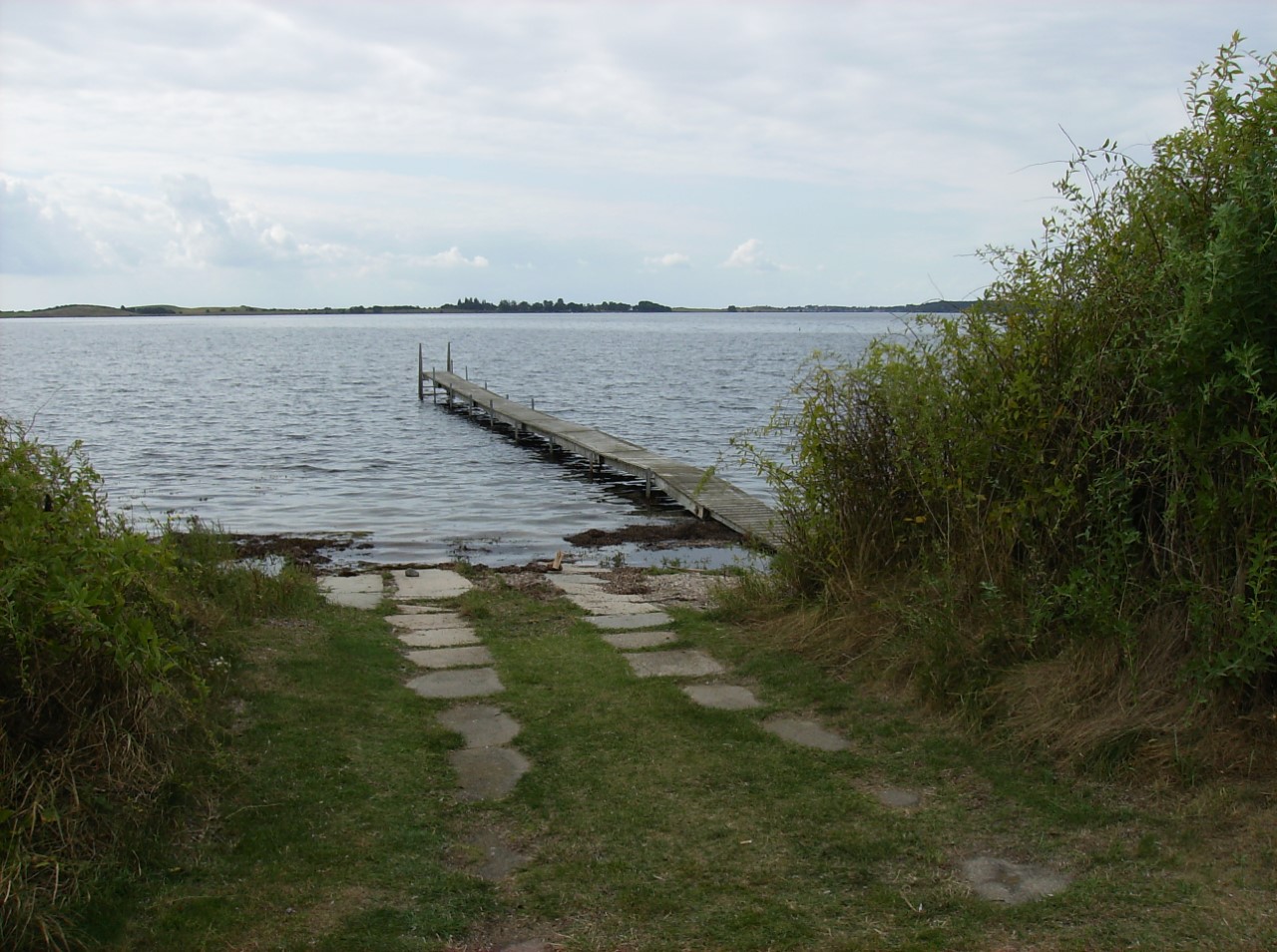
We can get an idea of the age of a city like Katterød from its name. In Danish, the last part of the name rød means ‘deforestation’. The word is related to rud (root) and rum (space). As in Upperud or Esrum. The tved of towns such as Egtved means the same thing. The act of clearing an area to build one or more houses is known from the Viking Age. The Vikings even took place names with them to England, where many smaller towns to this day end in ‘thwaite’ and ‘thorpe’ and other words from the Old Norse language. Towns with names ending in rød probably date from the late Viking Age and early Middle Ages. What we know for sure about Katterød is that the town was first mentioned in 1412. At that time it was spelled Kathæreuthe.
13
KM
Nab
Strand
A lovely beach – with a public toilet
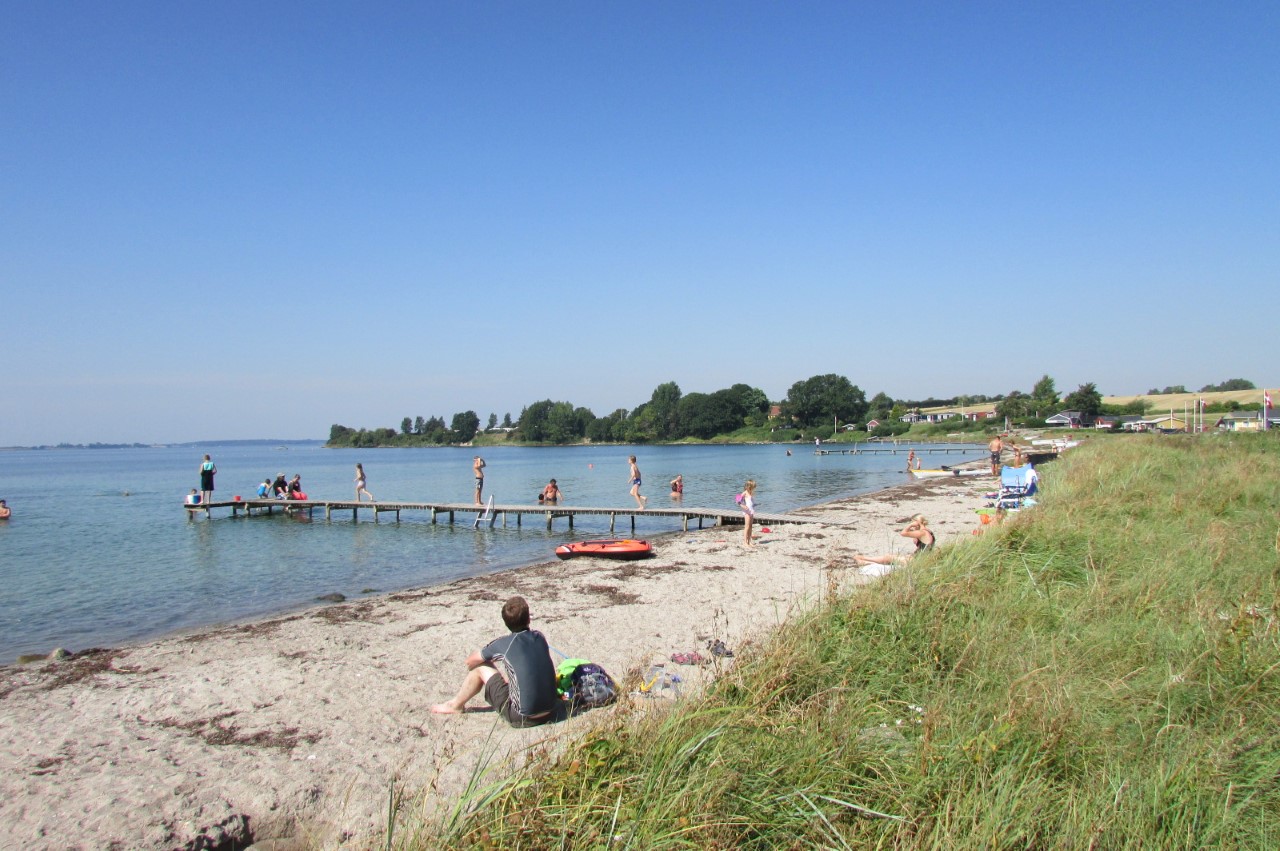
If the weather has been hot on your trip – or of you just fancy a dip – take a detour to Nab Beach. It is a good public beach. There is also a toilet here.
15
KM
Svelmø
Jump in and dip your toes (and thighs)
You are cycling around the Southern Funen Archipelago. At Svelmø you can dip your toes (and your thighs) by taking Ebbevej and walking the 500 metres across to the island. You can also get a ride on the truck bed, when Jan drives the tractor for guided (https://www.visitfaaborg.dk/faaborg/planlaeg-din-tur/svelmoe-oehavets-ukendte-oe-gdk1089542) tours on Mondays, Thursdays and Sundays during the summer.
While walking or driving over, just think – you are crossing the world’s largest flooded Ice Age landscape. It was in the Stone Age that the landscape was first flooded. Before that, people lived where you are walking. However, when the ice melted, the sea created the unique natural landscape, featuring the 55 islands and islets, which the water could not reach. But which you can visit – on foot in the case of Svelmø – or on ferries and via bridges. Find the largest islands in the Archipelago here and go island hopping.
17
KM
Prinsesse
Eleonora
Three castles as a morning gift
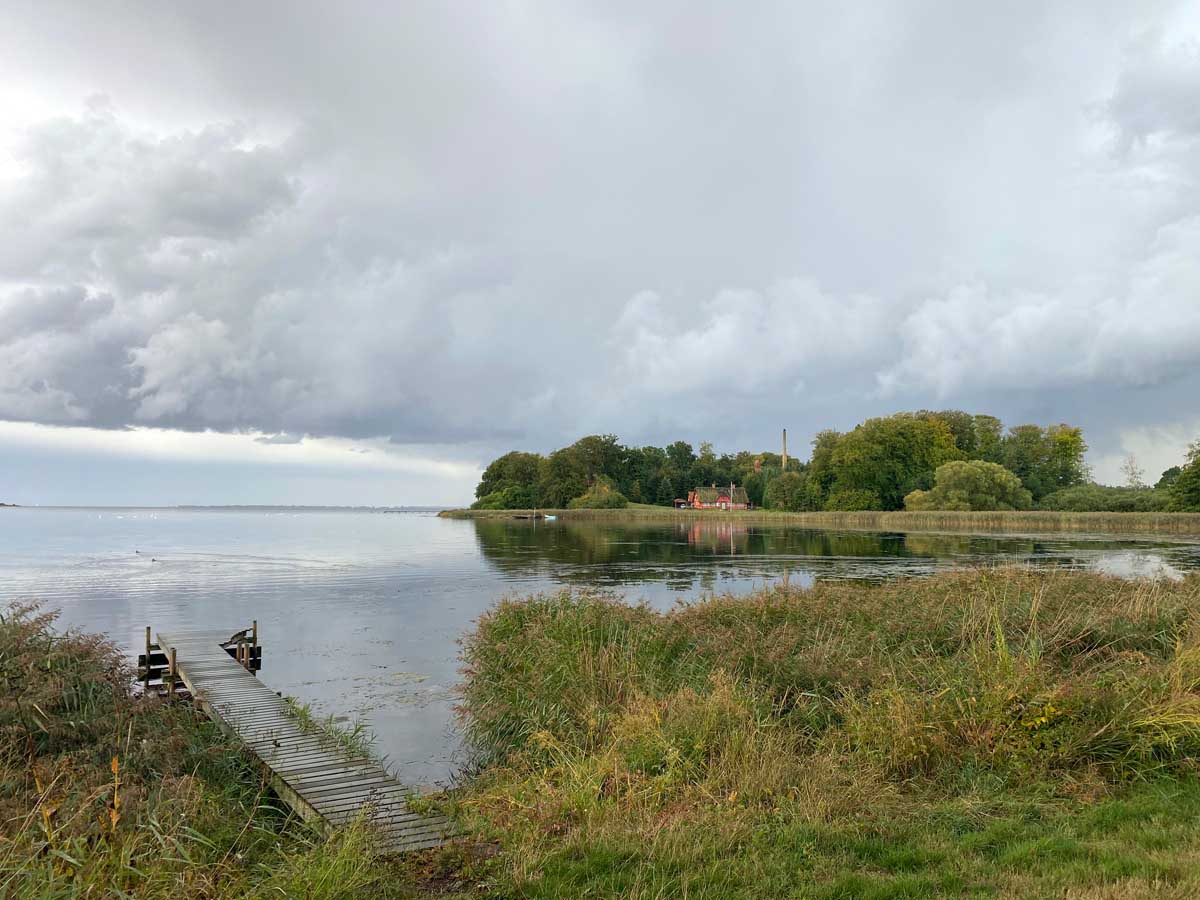
Make a stop when you reach Fiskholm and the Dam. Maybe take a little detour to the marina in Fjællebro and shudder at the tragic story of Princess Eleonora. This is what happened.
On 23 July 1229, the wedding of the year took place in Ribe. The 18-year-old Portuguese princess, Eleonora was married to Valdemar the Young, son of Valdemar II the Victorious. She had arrived in Denmark by ship. On 25 June she was given a morning gift, which today can rightfully be called the birth certificate of Faaborg and Svendborg. Because, in the deed of gift, King Valdemar II the Victorious wrote: “that Eleonora, Queen of Denmark, has received as a morning gift half of Funen, specifically the southern part, in which the three castles of Swineburgh, Wordburgh and Foburgh are located, and half of the tax revenue from the same region and the whole of the city of Odense.”
If it had been a fairy tale, Valdemar and Eleonora would have lived happily ever after. Unfortunately, the story turned into a tragedy. Because, just 3 years after the young couple were wed, Eleonora died in childbirth. The child also died. Then, just 3 months after Eleonora’s death, Valdemar the Young was hit by a gunshot during a hunt at Refsnæs and died of his wound.
Only a few traces of Wordborg Castle remain. And the story is almost 1,000 years old. But we still talk about it. Also because it is the first time we see the names Svendborg and Faaborg in writing. Faaborg was originally spelled ‘Foburgh’, which is believed to mean ‘Fox’s Castle’.
18
KM
Rødkilde
Gods
When you drive on Strandvejen outside Vester Aaby, you are in Rødkilde country. The estate itself is not open to the public. But it has been a part of the area’s history for a very long time. The history of the manor can be traced back to around the 14th century. The earliest-known owner of Rødkilde was Tyge Lauridsen Abildgaard. He owned the farm until 1314 and was a knight and chamberlain to the king, Erik Menved. But he clashed with the king and was convicted of treason. As a result, he also lost Rødkilde. Today, 320 of the estate’s 400 hectares are farmed on the basis of varied crop rotation, alternating between white clover, common meadow-grass, spinach seed, rapeseed and even marigolds. Yet farming accounts for only 11% of the revenue. Most comes from selling ATVs – all terrain vehicles. Today, it is difficult for an estate to make ends meet if they concentrate solely on farming.
During the 13th and 14th centuries, the situation was very different. Estates, the king and the Church forced free farmers to become copyholders. When a farmer took a copyhold, he was allowed to live on a farm and cultivate the land that belonged to it, in exchange for paying taxes to the landowner in the form of money, crops and/or labour.
The copyhold system began in the mid-13th century. 150 years later – in the early 15th century – only just over 10% of farmers were freeholders: a number that was further reduced and almost halved by the 17th century.
24,3
KM
Gundestrup
Dairy and
Brewery
Beer and cheese in perfect harmony
Denmark is an agricultural country and we produce large quantities of milk, butter and cheeses. However, the majority of Danish cheeses were inspired by foreign cheeses. But we have one type of cheese that is our very own. Smoked cheese. The Danes have probably been enjoying this cheese since the Viking Age. Today it is a speciality of Funen. And Gundestrup Dairy is an expert. Handmade smoked cheese is the dairy’s passion.
If you are lucky, the shop will be open when you stop by. Currently it is open on Thursdays and Fridays from 2.00 to 5.00 pm, and on Saturdays from 10.00 am to 1.00 pm*. Then you will have the pleasure of washing down some cheese with the dairyman’s best beer. Beer is the dairy’s second passion, and the range includes everything from thirst-quenching apple-wheat beer, ales and IPAs to a full-bodied stout aged with roasted oak shavings. Or how about the speciality of the place? A Duppel Bock brewed with whey, which is a by-product of cheese production.
Take your cheese and beer out into the sunshine and enjoy an al fresco lunch.
* Just to be sure, check the opening hours on the dairy’s website. (https://mejeri-bryg.dk/butikken/)
The best
viewpoint
of the trip
Take a detour and discover two manor houses and a vantage point

On this route you will see Hvidkilde Gods, pass the area’s most prominent vantage point and get close to Skjoldemose Gods.
When you leave Faaborg, turn left in Stågerup away from the route and continue on Rødmevej.
After 1.5 km you pass the estate of Skjoldemose Gods.
Continue towards Rødme, then take Egebjergvej on the right. After about 1 km, turn right onto Alpevej. At the highest point of Alpevej, you can visit Egebjerg Mill. Here, 110 metres above sea level, there are magnificent views of Central Funen and out over the South Funen Archipelago with Tåsinge and Langeland in the south, and of Ærø to Als in the west. On a clear day you can see Germany! If you want to get the big picture of the area, this is a must-see.
Continue along Alpevej, which turns into Skovmarksvej. When Skovmarksvej inclines to the right, turn left onto Nielstrupvej, which ends in the main road between Faaborg and Svendborg. Turn left and take care. The road is so narrow that a decision has been made to construct a cycle lane in a few years’ time. That will be wonderful. Until then, drive in single file. Past the estate of Hvidkilde Gods. Until you come to Hvidkildevej on the right. Drive straight out at the intersection at Hellegårdsvej. Along Egense Kirkevej. Then you are on the route again.
28
KM
Gorilla
Park
Try a BMX ride in the treetops
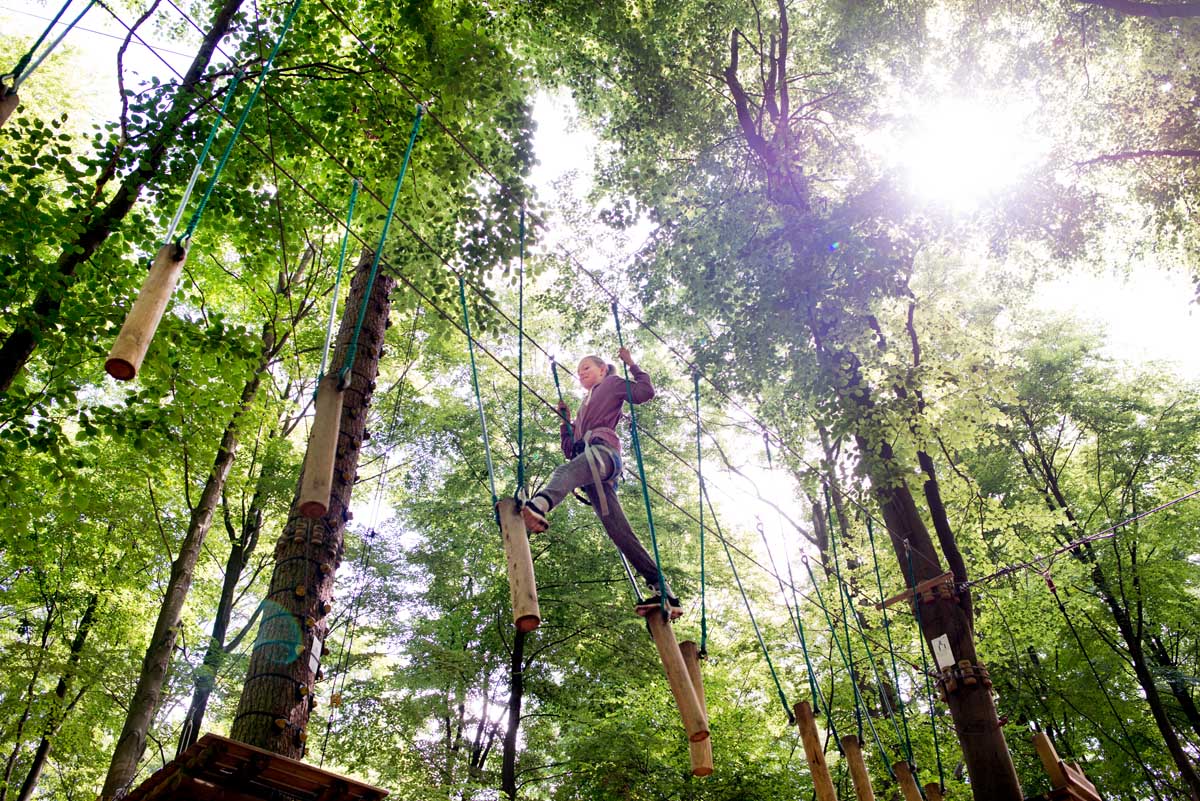
If you feel like a break from your trip around Funen on the road, then park your bikes and go for a climb. In Gorilla Park you can go crazy and experience a wild rush at a height of 26 metres. There is a 2.7-km ropes course with more than 100 different climbing elements. They are divided into 8 ropes courses with difficulty levels ranging from easy to very difficult.
Come along. Try riding a BMX in the treetops, snowboards, base jumps and much more. Enjoy a terrific day in Gorilla Park.
You can enjoy a bite to eat and a drink in the park’s café, which serves ice cream, cake, burgers, sandwiches, coffee, soft drinks, beer and a terrific view of the Archipelago and all the way to Ærø.
See the opening hours here. (https://gorillapark.dk/booking/)
28
KM
Skjoldemose
Gods
Rent a hunting lodge and spend a few days.
The history of Skjoldemose stretches back more than 600 years. It is one of the only estates in Denmark to be built in late Renaissance style. The present buildings were constructed by the vassal Otto Krag in 1662.
The various lords and ladies of Skjoldemose Gods were often close to Denmark’s innermost circles of power. For example, Christian Friis was Chancellor during the reign of King Christian IV. The aforementioned Otto Krag became a member of the Council of State in 1648. Sofie Juel, the daughter of the naval hero Niels Juel, managed the estate for over 10 years in the early 18th century. Meanwhile, in the early 19th century, Christian Fredrik Berg was a pioneer in the fight against the forced labour of farmers for landowners and for the much-needed land reforms that followed.
In 1905, the estate was bought by Justus Sigismund Ulrich and is still owned by the family.
The manor is not open to the public. But if you would like a guided tour of the garden and the farm, contact Desiree Bretteville Ulrich (desiree@skjoldemose.dk) to find out the options.
- The estate has a hunting lodge, which you can rent for the night. It accommodates six people. But you need to book well in advance. It is extremely popular. Interested? Then, take a look here (http://www.skjoldemosegods.dk).You may be lucky to find it is available.
PPS: If you fancy a bite to eat, there is a café up in Gorilla Park, where you can enjoy the view of Ærø with a burger, cake, sandwich, coffee, ice cream etc. For opening hours: See Gorilla Park.
32
KM
Ollerup
Bunker
The technology of war is often reflected in the buildings you can see and explore on your tour. During the late Middle Ages, the military dramatically increased its firepower. Accordingly, the outer walls of castles were strengthened. You can see this, for example, at Tranekær Castle on Langeland and at Nyborg Castle, where, in the 1550s, the outer walls were reinforced, becoming 3 metres thick as opposed to their original 1.25 metres. More recently, we built bunkers as protection against enemy bombs. You will pass right by one of them in Ollerup. It is German. In 1943, the Germans seized the three free schools in the town to accommodate around 800 men. To protect them, in January 1944, the Germans built a complex of three bunkers and about 100 metres of corridors. The facility is still standing. There are three small exhibitions in Danish. There are benches and tables at the bunker complex with beautiful views of Hvidkilde Lake. So, take a break. Enjoy your lunch. Relax.
The bunker is open to visitors around the clock from 1 May to 31 October.
PLEASE NOTE: You will not pass the Ollerup Bunker if you took the detour with two manor houses and a vantage point.
33
KM
Hvidkilde
Gods
Sometimes a manor started out as a manorial farm in a village. Others were ‘enestegårde’ (autonomous farms). In other words, the farm was isolated and did not belong to any farming community. Hvidkilde Gods started as an autonomous forest farm. So, not only was it autonomous; it was also located in a forest.
Hvidkilde was referred to as a manor as early as 1374 – in the midst of the great agricultural crisis, during which the Black Death (the plague) played a prominent role. By the mid-14th century the plague had claimed the lives of almost every second Dane. There were deserted farms and estates all over the country. There was a drastic shortage of labour. This lack of manpower was probably the reason why farming methods were radically changed. In order to attract labour, the squire was compelled to provide his farmers with better conditions. Whereas the first copyholds consisted of many small farms and rural residents without their own land, the operation was stabilised during the 15th century with fewer copyholders, who were given more land to manage. This gave the farmers higher status, better living conditions and their own responsibility for the operation of the leased fields and stables, the latter together with the other copyholders in the villages.
The main building of Hvidkilde can be traced back to 1550. But it was rebuilt after a fire, and most recently rebuilt and extended in 1725, turning the manor house into a veritable Baroque mansion.
Today, the main building is the home of the Ahlefeldt-Laurvig-Lehn family. The estate is not open to the public.
PLEASE NOTE: You will only get close to Hvidkilde Gods, if you take the detour to two manor houses and a vantage point.
40
KM
St. George’s
Church and
Monastery
When the sick had to wear bells
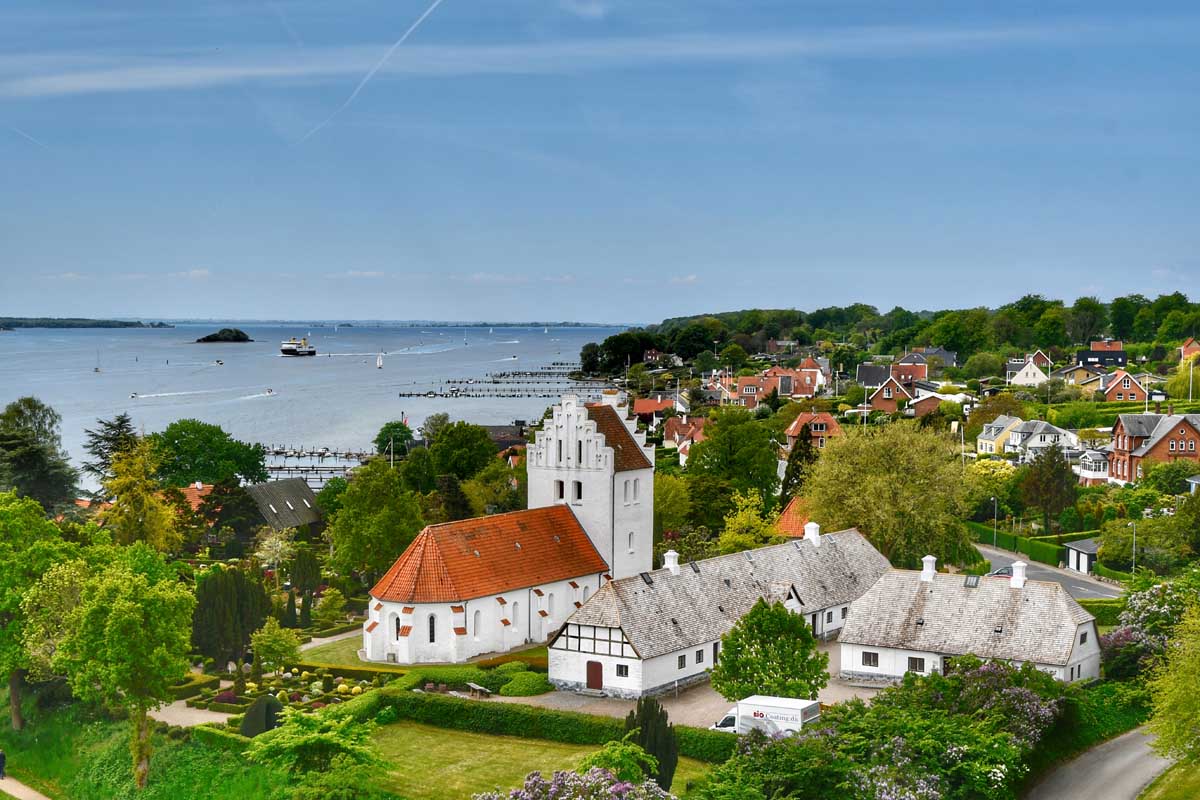
Leprosy was a widespread disease in the 13th and 14th centuries. The disease resulted in horrific deformities and had a terrible impact on those afflicted. Healthy people believed that lepers had been branded by God’s wrath and expelled them from society. Those who were able to walk had to beg in towns and cities, but had to wear bells to warn people of their condition, so respectable citizens could maintain appropriate distance. They could attend church services, but had to remain outside the church and look in through the windows. The Church was the only authority that could and would do something for those affected. Across Europe, the Church built leprosy hospitals. In Denmark, there were about 35 ‘hospitals’, known as ‘Sankt Jørgensgårde’ (St. George Yards). St. George’s Monastery at Svendborg is the only preserved hospital for lepers in Denmark. The name is a bit misleading, because it was never actually a monastery. It was a place where the clergy could nurse the sick, while not being able to do anything about the actual disease. The monastery and church were built at a safe distance from the town gates – about 1200 metres west of the town limits. This partial isolation of the lepers helped prevent the disease from spreading. Leprosy peaked in the 13th century and by the end of the 15th century had almost disappeared. The hospital then became a poorhouse, supervised by Hvidkilde Gods. Today the place serves as a parish hall.
St. George’s Church and Monastery are located about 1 km off the route. If you want to get close to the church, follow the on-site road signs.
42
KM
Svendborg
Text
The period from 1340 to 1523 witnessed no end of hardship in the shape of war, disease and climate change. But there was also progress. Denmark recovered from bankruptcy and went on to become a northern European superpower. The distribution of power between the established population groups changed. The foundations of statehood as we know it today were laid.
Practical links to points of departure and destinations
Discover Svendborg (click here)
Attractions in Svendborg (click here)
Where to eat and drink in Svendborg (click here)
Where to stay in Svendborg (click here)
Discover Faaborg (click here)
Attractions in Faaborg (click here)
Where to stay in Faaborg (click here)
GET YOUR ‘STAGE BADGE’
You have completed the Svendborg/Faaborg stage. Great! Well done! You have earned a badge as proof of your efforts. Download it as an image here and save it in your photo archive. Share your achievements with your friends. Upload your badge on Instagram, for example, using hashtags such as #herrregårdsruten, #fæstebondenogherremanden, #bikeislandfyn etc.

